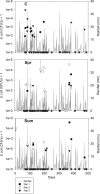Long-term persistence and leaching of Escherichia coli in temperate maritime soils
- PMID: 20038692
- PMCID: PMC2832400
- DOI: 10.1128/AEM.02335-09
Long-term persistence and leaching of Escherichia coli in temperate maritime soils
Abstract
Enteropathogen contamination of groundwater, including potable water sources, is a global concern. The spreading on land of animal slurries and manures, which can contain a broad range of pathogenic microorganisms, is considered a major contributor to this contamination. Some of the pathogenic microorganisms applied to soil have been observed to leach through the soil into groundwater, which poses a risk to public health. There is a critical need, therefore, for characterization of pathogen movement through the vadose zone for assessment of the risk to groundwater quality due to agricultural activities. A lysimeter experiment was performed to investigate the effect of soil type and condition on the fate and transport of potential bacterial pathogens, using Escherichia coli as a marker, in four Irish soils (n = 9). Cattle slurry (34 tonnes per ha) was spread on intact soil monoliths (depth, 1 m; diameter, 0.6 m) in the spring and summer. No effect of treatment or the initial soil moisture on the E. coli that leached from the soil was observed. Leaching of E. coli was observed predominantly from one soil type (average, 1.11 +/- 0.77 CFU ml(-1)), a poorly drained Luvic Stagnosol, under natural rainfall conditions, and preferential flow was an important transport mechanism. E. coli was found to have persisted in control soils for more than 9 years, indicating that autochthonous E. coli populations are capable of becoming naturalized in the low-temperature environments of temperate maritime soils and that they can move through soil. This may compromise the use of E. coli as an indicator of fecal pollution of waters in these regions.
Figures





Similar articles
-
Presence and growth of naturalized Escherichia coli in temperate soils from Lake Superior watersheds.Appl Environ Microbiol. 2006 Jan;72(1):612-21. doi: 10.1128/AEM.72.1.612-621.2006. Appl Environ Microbiol. 2006. PMID: 16391098 Free PMC article.
-
Risk Factors for Detection, Survival, and Growth of Antibiotic-Resistant and Pathogenic Escherichia coli in Household Soils in Rural Bangladesh.Appl Environ Microbiol. 2018 Nov 30;84(24):e01978-18. doi: 10.1128/AEM.01978-18. Print 2018 Dec 15. Appl Environ Microbiol. 2018. PMID: 30315075 Free PMC article.
-
Characterization of environmentally persistent Escherichia coli isolates leached from an Irish soil.Appl Environ Microbiol. 2010 Apr;76(7):2175-80. doi: 10.1128/AEM.01944-09. Epub 2010 Feb 12. Appl Environ Microbiol. 2010. PMID: 20154122 Free PMC article.
-
Escherichia coli contamination of lettuce grown in soils amended with animal slurry.J Food Prot. 2013 Jul;76(7):1137-44. doi: 10.4315/0362-028X.JFP-13-011. J Food Prot. 2013. PMID: 23834787
-
Sources, pathways, and relative risks of contaminants in surface water and groundwater: a perspective prepared for the Walkerton inquiry.J Toxicol Environ Health A. 2002 Jan 11;65(1):1-142. doi: 10.1080/152873902753338572. J Toxicol Environ Health A. 2002. PMID: 11809004 Review.
Cited by
-
Impact of homologous and non-homologous recombination in the genomic evolution of Escherichia coli.BMC Genomics. 2012 Jun 19;13:256. doi: 10.1186/1471-2164-13-256. BMC Genomics. 2012. PMID: 22712577 Free PMC article.
-
Transmission of Escherichia coli from Manure to Root Zones of Field-Grown Lettuce and Leek Plants.Microorganisms. 2021 Nov 3;9(11):2289. doi: 10.3390/microorganisms9112289. Microorganisms. 2021. PMID: 34835415 Free PMC article.
-
The arable ecosystem as battleground for emergence of new human pathogens.Front Microbiol. 2014 Mar 20;5:104. doi: 10.3389/fmicb.2014.00104. eCollection 2014. Front Microbiol. 2014. PMID: 24688484 Free PMC article. Review.
-
The influence of social structure, habitat, and host traits on the transmission of Escherichia coli in wild elephants.PLoS One. 2014 Apr 4;9(4):e93408. doi: 10.1371/journal.pone.0093408. eCollection 2014. PLoS One. 2014. PMID: 24705319 Free PMC article.
-
Indicator bacteria community in seawater and coastal sediment: the Persian Gulf as a case.J Environ Health Sci Eng. 2017 Mar 10;15:6. doi: 10.1186/s40201-017-0266-2. eCollection 2017. J Environ Health Sci Eng. 2017. PMID: 28293427 Free PMC article.
References
-
- Abu-Ashour, J., and M. Abu-Zreig. 2005. Effect of interstitial velocity on the adsorption of bacteria onto soil. Adsorp. Sci. Technol. 23:535-542.
-
- Abu-Ashour, J., D. M. Joy, H. Lee, H. R. Whiteley, and S. Zelin. 1998. Movement of bacteria in unsaturated soil columns with macropores. Trans. ASAE 41:1043-1050.
-
- Abu-Ashour, J., D. M. Joy, H. Lee, H. R. Whiteley, and S. Zelin. 1994. Transport of microorganisms through soil. Water Air Soil Pollut. 75:141-158.
-
- Aislabie, J., J. J. Smith, R. Fraser, and M. McLeod. 2001. Leaching of bacterial indicators of faecal contamination through four New Zealand soils. Aust. J. Soil Res. 39:1397-1406.
-
- Artz, R. R. E., and K. Killham. 2002. Survival of Escherichia coli O157:H7 in private drinking water wells: influences of protozoan grazing and elevated copper concentrations. FEMS Microbiol. Lett. 216:117-122. - PubMed
Publication types
MeSH terms
LinkOut - more resources
Full Text Sources

